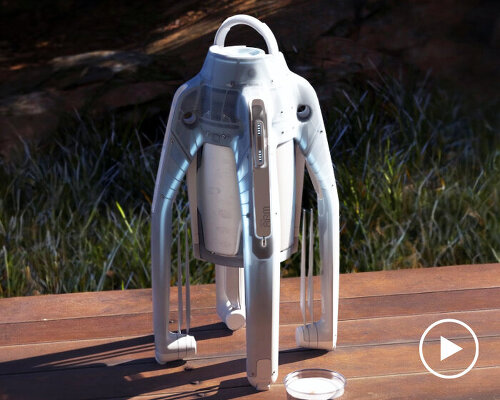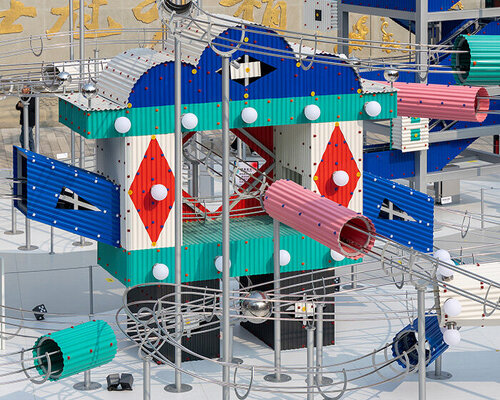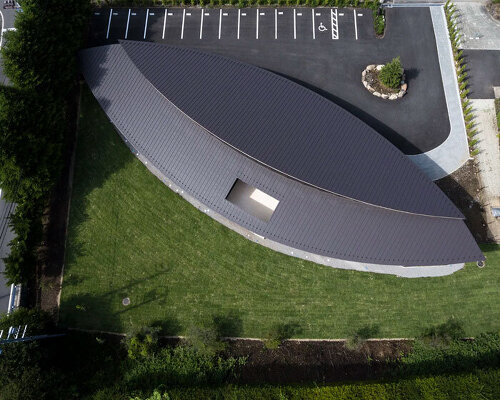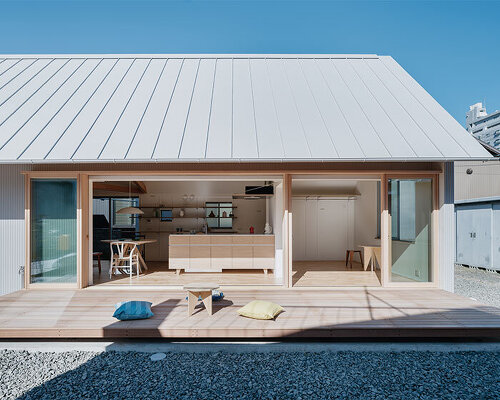Eight Indigenous technologies that could turn the tide on how we manage water


Architect Julia Watson has followed up her seminal book Lo-TEK with a new volume focused specifically on Indigenous approaches to water – its scarcity and overabundance. Here, she shares an exclusive preview of eight examples from floating farms to sponge parks.
With the first Lo-TEK book, subtitled Design by Radical Indigenism, Watson introduced readers, many for the first time, to the idea of TEK, or traditional ecological knowledge.

These are building, landscaping and farming practices that belong to the world's Indigenous communities and hold great lessons for Western practitioners trying to design for climate resilience.
With Lo-TEK Water, the Australian architect wanted to take a deep dive into water as the element linking four different climate-related disasters: droughts, flooding, sea-level rise and extreme storms.
The book also puts more of a focus on instances where TEK and contemporary urban design are already working together.
"Through the lens of water, I wanted to understand the potential of hybridisation and co-design," Watson told Dezeen. "How does a non-Indigenous design practice or scientist or institution work with an Indigenous community and their knowledge to shape some of the most resilient urban landscapes?"
"And with urbanism, I'm talking about cities, villages, rural landscapes, peri-urban landscapes – not just city landscapes."

Co-authored with Indigenous knowledge keepers and experts, Lo-TEK Water features both traditional and contemporary projects from countries including Mexico, China, Tunisia, Canada, Peru and India.
"There are so many varied ways in which traditional ecological knowledge is being merged with engineering systems, cladding, roofing – in architecture but also in landscape, creating really large-scale infrastructures and our most resilient urban parkland on the planet," Watson said.
Read on for Watson's introduction to eight key projects from the book, showing the diversity of ways that water-based TEK shows up around the world.

Yakchal ice houses, Iran
"In the deserts of Persia, domes of earth once preserved ice through summer's heat (top image by Adam Jones). These yakchals – vaulted, subterranean and oriented to the wind – captured night air and stored cold within their thick adobe walls. Their geometry distilled centuries of climatic intelligence, transforming raw earth into an instrument of equilibrium.
"In today's drylands, the design studio Emerging Objects revives this lineage with 3D-printed adobe forms (above) that reinterpret yakchals' thermodynamics through digital craft. Clay, once tamped by hand, is now extruded by code, yet the principle is unchanged: cooling through breath, stability through soil.
"Across millennia and media, the same lesson endures – that technology begins in the earth, and climate design is an act of remembering."

Ramli sand island beds, Tunisia
"Between the slopes of Tunisia's Ennadhour Mountain and the Mediterranean, a living architecture of sand endures. Forged by Andalusian exiles in the 1600s, the ramli farms of Ghar El Melh and Sidi Ali El Mekki emerged as small earthen islands suspended between tides. Each bed of sand and manure floats just above the brackish lagoon, balanced to capture a thin lens of fresh water sustained by rainfall and mountain runoff. Roots descend into this hidden layer, drinking from its wellspring while resisting the salt below.
"The ramli are both field and filter, built by hand and tuned to the shifting hydrology of the coast. Their construction reshapes the lagoon's edge with every tide: beds rebuilt, contours shifted, dikes repaired. Within this ephemeral terrain, agriculture becomes a form of listening. Each gesture of planting and repair answers the lagoon's breath, keeping fertility alive where salt and drought should prevail.
"Across four centuries, this sandy wisdom endures, neither fixed nor forgotten – an architecture that floats in place, anchored by knowledge as much as by earth."

Mithache agor salt pans, India
"Along Goa's tidal estuaries, where saline and freshwater intertwine, the mithache agor salt pans glint in the sun like tiled mirrors of the sky. Carved from Khazan wetlands more than a millennium ago, they follow the moon's rhythm, their sluice gates drawing seawater through a sequence of evaporation ponds until it hardens into crystal. Each wall, channel and bund carries the memory of collective labor – an economy of salt sustained by tidal precision.
"When the rains return, the pans surrender to flood, transforming into aquaculture ponds that replenish soil and feed the mangroves. This seasonal metamorphosis turns a geometric landscape into a living cycle of water and renewal. The architecture of the agor is both industrial and ecological – each crystal of salt a record of equilibrium between people and tide.
"As new coastal infrastructures emerge to mitigate rising seas, they must echo this quiet heritage: design that moves with the monsoon rather than against it."

Aech fish weirs and Swinomish clam gardens, USA
"Across the intertidal flats of the Pacific Northwest, curving lines of stone trace an ancient agreement with the sea. The aech fish weirs (above) appear as seaward-pointing arrows visible from space. They are built from rock walls laid by hand, guiding salmon and herring for over three millennia. Their geometry tuned the flow of the tide, creating shallow pools that fed both people and the fish they caught. These walls were never barriers – they were instruments of reciprocity, shaping abundance through balance.
"In the same ocean, the Swinomish people have revived clam gardens that terrace the shore, stacking stones to hold sediment and expand habitat. As tides ebb, the terraces slow erosion and nurture shellfish, mitigating sea level rise and storm events while restoring the productivity of a shoreline once lost to colonial erasure.
"In both systems, human construction amplifies ecological function: the weir and the garden as living infrastructures of care. What returns to the tide today is not nostalgia but continuity – the resurgence of a coastal knowledge that reads the water as kin."

Floating chinampa fields of Tenochtitlan, Mexico
"In the shallow waters of Lake Xochimilco, islands of soil and reed shimmer like a woven quilt. These chinampas – floating fields anchored by willow trees – turned the pre-colonial Aztec capital of Tenochtitlan into an amphibious city where agriculture, water purification and habitation existed as one. Canals acted as arteries, cleaning water, carrying nutrients, sequestering carbon and cooling air, while each chinampa recycled the lake's silt into fertile ground, offering up to eight harvests a year.
"When the colonial city drained its lakes, it severed this hydrological intelligence. Yet fragments of the chinampa system endure – and in their revival, Mexico City rediscovers the logic of its own foundation (above).
"Designers now read these ancient grids as prototypes for sponge-city urbanism – networks of gardens and canals that absorb floods and cleanse the air. Beneath the modern capital's concrete skin, the lake still pulses, waiting to be acknowledged once more, offering solutions for the constant flux of flood to drought."

Totora reed insulation, Peru
"On the high-altitude waters of Lake Titicaca, the Uros people build floating worlds from totora reed. Gathered from the shallows, it becomes island, house and vessel – its buoyancy maintained through constant renewal. Each platform rises and decays with the lake, rebuilt layer by layer in rhythm with the seasons.
"After the 2016 Peruvian earthquake, artisans and researchers at Centro Tierra translated this ancient craft into insulation panels for modular housing (above). The same reed that carries entire villages now shelters them from cold and tremor, combining flexibility with strength.
"Totora embodies the principle of cyclical design: architecture that is not permanent, but perpetually reborn. From floating archipelago to seismic shelter, it teaches that resilience grows from renewal, not resistance."

Sangjiyutang farming system, China
"In the river deltas of Guangdong, networks of ponds and dikes unfold like a living mosaic. The Sangjiyutang system (above) entwines fishponds, mulberry trees and silkworms in a continuous cycle: mulberry trees feed silkworms, silkworms feed fish, fish fertilize ponds and ponds temper floods, while the mud drawn from the bottom closes the loop to fertilize the trees.
"It is an ecosystem sustained by patterns rather than control, where agriculture, aquaculture, textile production and forestry merge into one metabolism. That ancient rhythm now reemerges in Sanya Mangrove Park, where engineered wetlands and tidal gardens absorb storm surges and purify runoff along China's urban coasts.
"Concrete and mangrove replace mulberry and silk, but the principle remains – a choreography of interdependence that blurs city and estuary. Across dynasties and design schools, this lineage of flood wisdom persists, showing that resilience lies in cooperation, not conquest."

Baira floating islands, Bangladesh
"Across the floodplains of Bangladesh, where land dissolves each year under the monsoon, farmers learned to float the earth itself. The baira – rafts of invasive water hyacinth and straw layered into fertile beds – turn inundation into harvest (above). As the waters rise, the gardens drift; as they fall, the decomposing rafts feed the fields below. Crops grow from instability, their roots drawing nourishment from the thin skin of water while cleansing it and offering native habitat.
"That same logic now reappears in distant geographies. On Seattle's Duwamish River, the Green Futures Lab cultivates floating wetlands that restore habitat to a river once industrialized beyond life. In Pakistan, the floating treatment wetlands of the National Institute for Biotechnology and Genetic Engineering clean contaminated waterways through aquatic planting.
"Across continents and generations, the method persists: the ability to grow in motion, to turn the flood from threat to field. The raft, whether of hyacinth or steel mesh, remains a living infrastructure for adaptation."
The post Eight Indigenous technologies that could turn the tide on how we manage water appeared first on Dezeen.















































